Dr.'s Kristin Drexler, Michelle Watts and Casey Skvorc continue their epic research project in Belize, investigating how small communities and indigenous peoples were impacted by COVID-19.
By Dr. Kristin Drexler, Faculty Member, School of STEM with
Dr. Michelle Watts, Assistant Department Chair, School of Security and Global Studies
As a follow-up to our previous COVID-19 research in Belize and Guatemala, Dr. Michelle Watts and Dr. Kristi Drexler recently traveled to Belize, Central America to continue our research with a visit to the small Yucatec Mayan community of San José Succotz. Our research, supported by 2022 and 2023 University grants, is called “A Case Study Comparison of Pandemic Experiences of Indigenous Groups in the Americas.”
Our research team consisted of three professors: ourselves and Dr. Casey Skvorc. We also have several student assistants at the undergraduate, master’s, and doctoral levels.
On Location in San José Succotz, Belize
In San José Succotz, we investigated how the village was impacted by the COVID-19 pandemic. Known locally as Succotz (pronounced “sah-kutz”), this small community is in the Cayo District of western Belize, slightly over six miles from the Belize-Guatemala border.
According to the chairlady of San José Succotz, Ms. Sherel Cocom, the population of Succotz is 4,860 people. The village consists mainly of people who are of Yucatec Maya descent, notes Belizing.
We were lucky to have our community guides: Lenney Gentle and Susan Panti. Lenney works as a conservation biologist, and Susan is the community health worker.

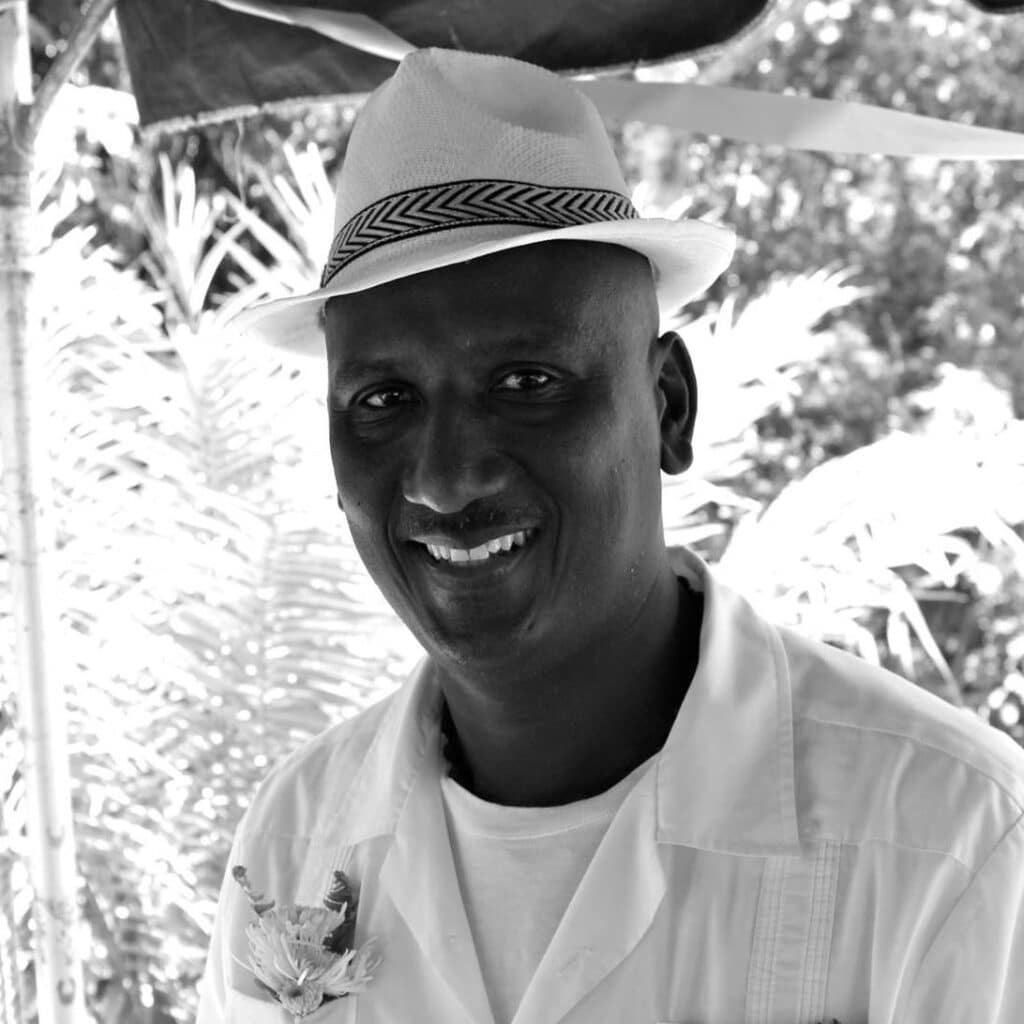 Our Succotz community guides, Susan Panti (left) and Lenney Gentle (being interviewed by Michelle). Images courtesy of Kristi Drexler and Lenney Gentle.
Our Succotz community guides, Susan Panti (left) and Lenney Gentle (being interviewed by Michelle). Images courtesy of Kristi Drexler and Lenney Gentle.
Succotz is just across the Mopan River from one of the most popular and impressive archaeological sites in Belize: Xunantunich (pronounced “shoo-nahn-too-nich”). Succotz is also known for its ethnobotany, the traditional use of plants for medicinal remedies and rituals.
Succotz has restaurants, an award-winning marching band, and its annual Succotz Fair, according to Belize.com. This event includes a celebration of “culture, folklore, dances and a fair featuring mechanical rides and traditional Mestizo and Maya cuisine such as bollos, tamales, escabeche, cochinita pibil, carne al pastor, beer drinking contests and dances with music from the best bands in Belize and invited music groups from Mexico and Guatemala.”
We stayed at a beautiful farm stay near Succotz called Nabitunich of San Lorenzo. Within sight of El Castillo at the Xunantunich Maya archaeological reserve, Nabitunich is a generational farm. According to the Nabitunich website, this farm was established in 1918 as a “cattle, poultry, horse, and grain farm [and] includes 100-year-old fruit orchards and timber reserves that serve as wildlife refuges.”
Near Succotz, at Nabitunich of San Lorenzo, we watched several wildlife species – keel-billed toucans, hummingbirds, parrots, oropendola, blue morpho butterflies, tree frogs, and other species – in and near the property’s majestic ceiba tree, a sacred tree of the Maya.
A Continuation of a Timely Study on Pandemic Impacts
Our COVID-19 research examines a variety of COVID-19 impacts to Indigenous communities. The visit to Succotz was a continuation of earlier survey and interviews in Alaska and New Mexico in 2022 and Belize and Guatemala in 2023.
To gauge how community residents responded to the pandemic, we conducted interviews in:
Metlakatla Indian Community in southeast Alaska (2022) Taos Pueblo in northern New Mexico (2022) Panajachel and San Jorge La Laguna village at Lago Atitlan (2023), and San Antonio Village in Belize with a feature of Mayan healer, Silverio CantoWe presented preliminary findings of this COVID-19 research at the Southeastern Council of Latin American Studies (SECOLAS) conference in Antigua, Guatemala, in late March.
The purpose of the study is to learn about the experiences of diverse Indigenous communities during the COVID-19 pandemic – to learn about their resilience and how they coped, adapted, and worked together to protect and provide for each other during the pandemic – and to add to the academic literature.
Our study examines multi-disciplinary factors, including health, social and cultural practices, livelihoods, the environment, governance, education, and resilience and uses the asset-oriented Community Capitals Framework, which Kristi has used in previous publications.
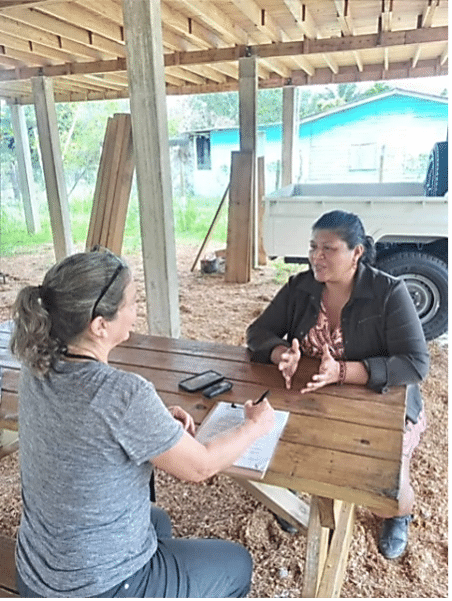
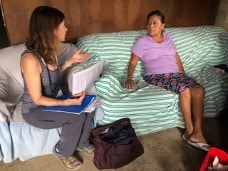

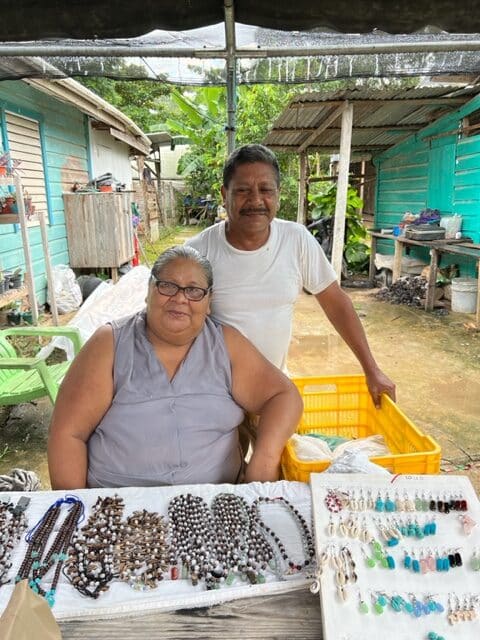
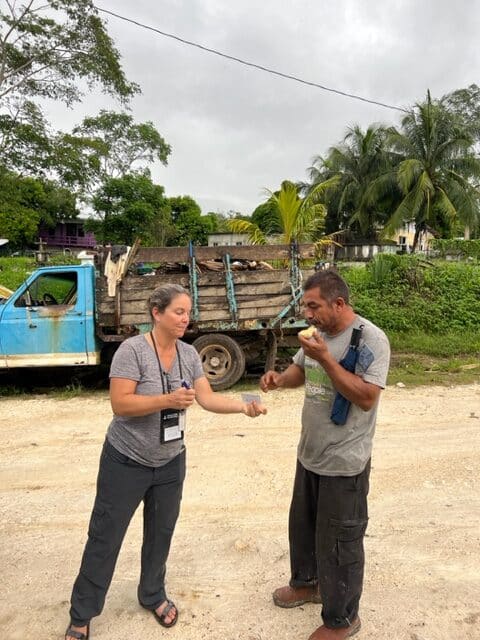
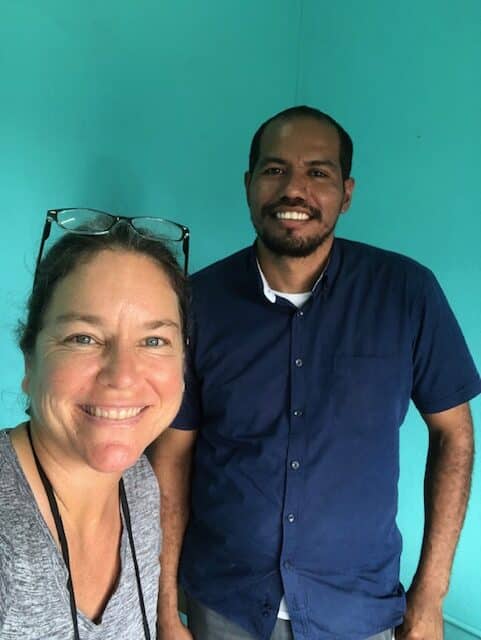
 Michelle and Kristi interview residents of Succotz. Images courtesy of Kristi Drexler, Michelle Watts, and Lenney Gentle.
Michelle and Kristi interview residents of Succotz. Images courtesy of Kristi Drexler, Michelle Watts, and Lenney Gentle.
The Succotz Research Experience
As a part of this trip, we discussed our experience in Succotz.
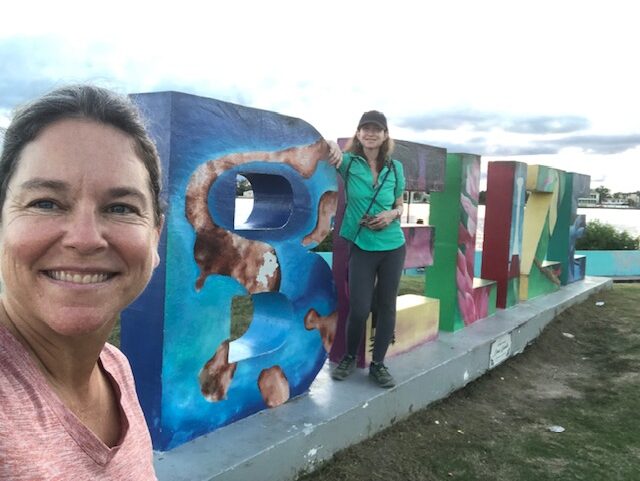 Kristi (left) and Michelle at the “Belize” sign in Belize City. Image courtesy of Kristi Drexler.
Kristi (left) and Michelle at the “Belize” sign in Belize City. Image courtesy of Kristi Drexler.Kristi: Hi, Michelle. First, what a pleasure it always is to work with you! So, we have completed most of our interviews for San Jose Succotz. How do you think the interviews went this time?
Michelle: Kristi, it’s been a pleasure to work and travel with you, too! I think the interviews went really well!
People in Succotz were really welcoming. While people often say they are grateful the pandemic has passed, many also still feel a sense of catharsis when they reflect on their experiences. Many thanked us for the opportunity to reflect on this difficult time.
Kristi: Why is this study important, and what do you want to do with the perspectives that people are sharing with us?
Michelle: It’s important to be aware of the experiences of other people and allow them to tell their stories. We have spoken to diverse groups who had a much different experience than what we did, especially in the United States.
One of the most important parts is giving our reports to the community. Having the lessons learned summarized is something they can share with others and keep for the future.
Maybe there will be some insights they hadn’t thought of before or stories they hadn’t heard. Also, it’s important to bring this research into the academic literature and ensure that there is literature on Indigenous peoples as well as a study which reflects on the Pandemic.
Michelle: Kristi, since you have a lot of experience in Belize, was there anything about the interviews you found interesting or surprising?
Kristi: First, let me say, Succotz has always been a lovely, lovely community. A lot of wonderful people and highly respected individuals live here – some of the best natural resources and ethnobotanical knowledge.
The same is also true for San Antonio from our interviews back in March. So, we were very lucky to have these interviews!
To me, Succotz seemed veryvulnerable to the virus due to their location near a major highway and next to the popular tourist destination of Xunantunich, though that was closed during the height of the pandemic. San Antonio, by contrast, was able to close their village roads entirely to anyone from outside.
But despite being potentially more vulnerable, the people of Succotz seemed to cope with the economic strain, curfews and closures well.they Many families already had internet and mobile devices, so the transition to online learning was perhaps easier.
If anything, I guess I was surprised to hear that youth sports in Succotz hasn’t rebounded as yet. Communities really need their youth and health-oriented activities, especially post-COVID. Sports and music – these are the things that are the heart of the community.
What a pleasure, I think, to have had the opportunity to interview people in Succotz andSan Antonio in this beautiful country. It’s been a very, very rewarding research experience to me – especially being able to examine responses from the lens of the Community Capitals Framework.
I’m loving this framework more and more because it shows the assets – the positives – of how a community can demonstrate its cohesiveness and resilience – not just during COVID, which is a huge thing – but, also this can be applied to large-scale disturbances like climate change and food security too.
Kristi: Michelle, was there anything that interested or surprised you during the interviews?
Michelle: Yes. In Succotz, there is someone local in their community, the nation’s epidemiologist, Dr. Russell Manzanero, who was prominent in leading Belize during the COVID-19 pandemic, similar to Dr. Anthony Fauci in the US.
And I think that’s really a source of pride, and maybe also that had an impact on the trust that people had in the government mandates.
Cahal Pech and the San Ignacio Green Iguana Conservation Project
Although weather conditions were rainy for most of our week of interviews, there was some time on Sunday to tour two important local sites in and around San Ignacio. We toured the Cahal Pech archaeological site and the San Ignacio Hotel’s Green Iguana Conservation Project.
According to Belize Hub, Cahal Pech (pronounced “ka-hal pech”) was built between 1500 and 1000 B.C. and is the “oldest-known Maya site in the Belize River Valley.”
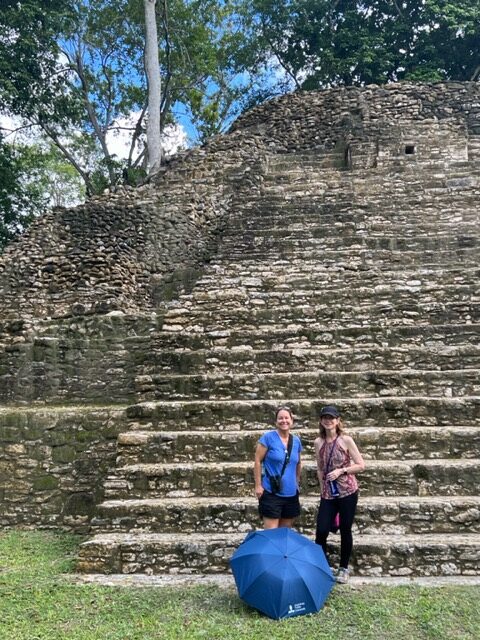

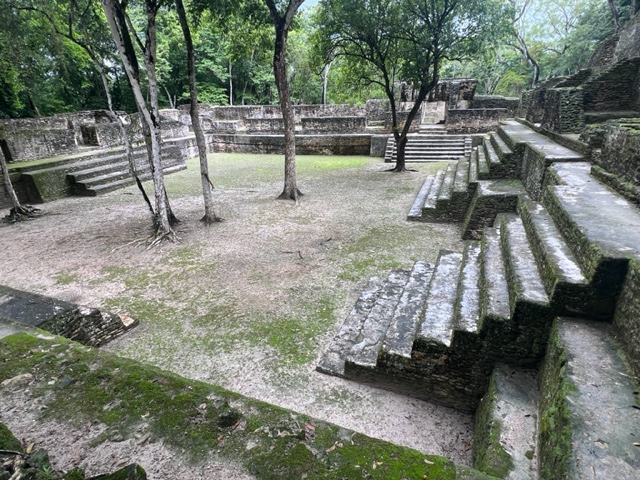 Kristi (left) and Michelle at Cahal Pech ruins in San Ignacio, Belize. Images courtesy of Keith Watts.
Kristi (left) and Michelle at Cahal Pech ruins in San Ignacio, Belize. Images courtesy of Keith Watts.
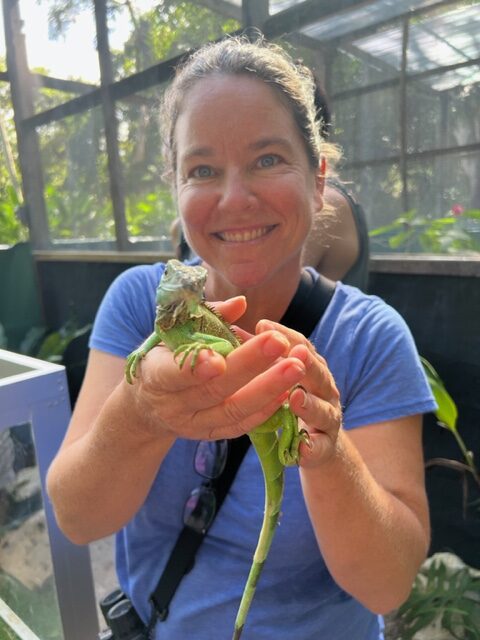
 Kristi (left) and guide, holding green iguanas at the San Ignacio Hotel’s Green Iguana Conservation Project. Images courtesy of Michelle Watts and Kristi Drexler.
Kristi (left) and guide, holding green iguanas at the San Ignacio Hotel’s Green Iguana Conservation Project. Images courtesy of Michelle Watts and Kristi Drexler.
Kristi’s Peace Corps Experience in Belize
Kristi was a Peace Corps Volunteer (PCV) in Belize in 1997-99. She lived adjacent to Cahal Pech and helped her Peace Corps cohort with various projects, such as the (I)guana Conservation Club (GCC) founded by Daniel Velazquez.
The GCC was part of the Green Iguana Conservation Project currently housed at the San Ignacio Hotel. Through GCC, Daniel, Kristi, and several other PCVs engaged at-risk youth in activities to conserve and protect the Macal River as a habitat for the green iguana. Kristi continues her service in Belize as a board member and vice-president of Full Basket Belize, a U.S. non-profit providing scholarships and small project grants.
Getting Involved in Indigenous Study at the University
For students at the University who are interested in joining a student organization, the University has a new chapter: the Society for Advancement of Chicanos/Hispanics & Native Americans in Science (SACNAS). Dr. Kristi Drexler and Dr. Michelle Watts are two of the faculty advisors. SACNAS promotes diversity in STEM in the contexts of social connections and sense of belonging, academic development, and professional development.
About the Authors
Dr. Michelle Watts is the Assistant Department Chair for the Department of Security and Global Studies, where she also teaches in the doctoral program. She has a degree in International Studies from American University, a master’s degree in Latin American Studies from the University of Arizona, and a Ph.D. in International Development from the University of Southern Mississippi.
Dr. Watts has collaborated with colleagues on nine research grants encompassing a wide range of topics. Her work includes “Bomberos, Maestros y Psicólogos: Guatemalan Civil Society Response to the Volcano of Fire Disaster,”“Making Sovereignty Mean Something: Native Nations and Creative Adaptation,” “Drugs, Thugs, and the Diablos Rojos: Perils and Progress in Panama,” “Seguridad del Canal de Panamá: Una Década Después de la Salida de Estados Unidos” (Security of the Panama Canal: One Decade after U.S. Departure), and “Game of Norms: Panama, the International Community, and Indigenous Rights.” She is the principal investigator for the research study, “A Case Study Comparison of Pandemic Experience of Indigenous Groups in the Americas.”









